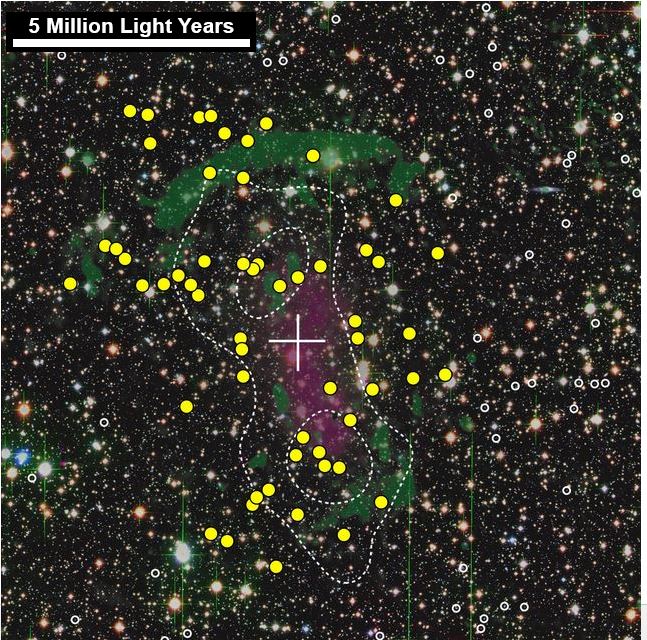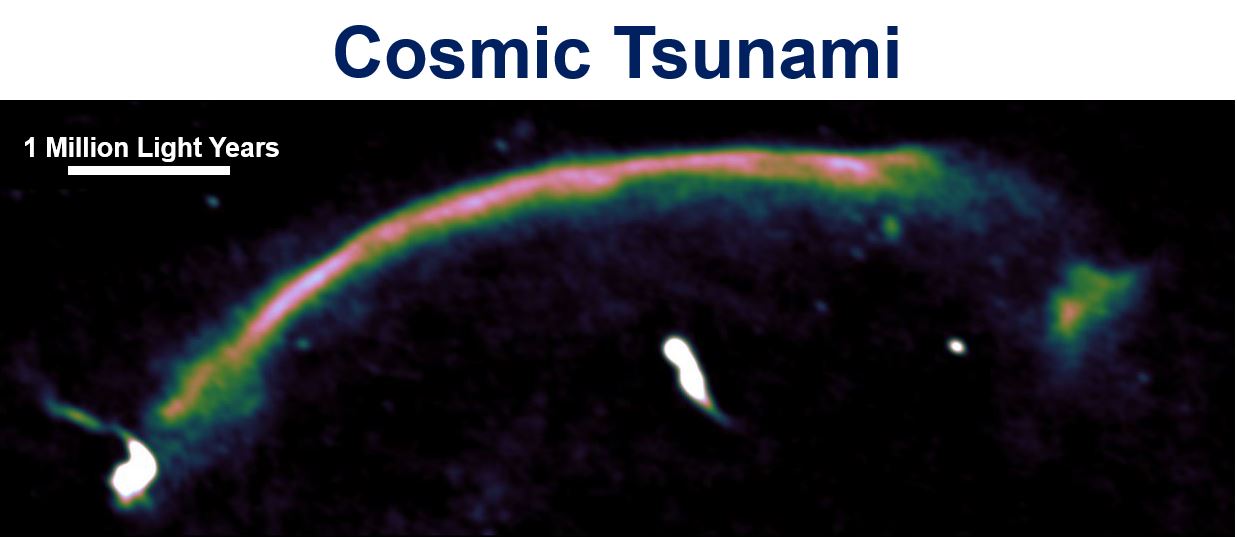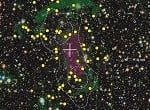Galaxies that stopped forming stars a long time ago, known as ‘red and dead’ galaxies, can come back to life when clusters of galaxies merge – the huge shock waves produced when they come together, sometimes referred to as cosmic tsunamis, can trigger the birth of a new generation of stars, scientists discovered.
An international team of researchers, led by Leiden Observatory’s Andra Stroe, and David Sobra, of Leiden and the University of Lisbon, wrote about their discovery in the academic journal Monthly Notices of the Royal Astronomical Society (citations below).
Galaxy clusters are similar to large cities, where thousands of galaxies are packed together, at least compared to the sparsely-populated space around them.

A composite image of the ‘Sausage’ merging cluster CIZA J2242.8+5310, made using data from the Subaru and Canada France Hawaii Telescopes (CFHT). (Credit: Andra Stroe)
In the same way cities absorb neighbouring towns as they grow, galaxy clusters build up structure in the universe over billions of years as they merge with adjacent clusters.
Mergers release colossal amounts of energy
As the clusters collide, there is a massive release of energy. The resulting shock wave travels like a tsunami through the clusters. However, until now, there had been no evidence that the galaxies themselves were much affected.
Sobral and Stroe observed the merging galaxy cluster CIZA J2242.8+5301, dubbed the ‘Sausage’, located 2.3 billion light years from Earth in the direction of the constellation of Lacerta, in the sky’s northern hemisphere.
The astronomers used the William Herschel and Isaac Newton Telescopes on La Palma, and the CFHT, Subaru and Keck Telescopes on Hawaii, and discovered that far from ‘watching from the back’ the cluster galaxies had been transformed by the shock wave, sparking the formation of a new generation of stars.
Comatose galaxies come back to life
Stroe said:
“We assumed that the galaxies would be on the sidelines for this act, but it turns out they have a leading role. The comatose galaxies in the Sausage cluster are coming back to life, with stars forming at a tremendous rate. When we first saw this in the data, we simply couldn’t believe what it was telling us.”
Their findings imply that galaxy cluster mergers have a significant impact on the formation of stars.
Stroe added:
“Much like a teaspoon stirring a mug of coffee, the shocks lead to turbulence in the galactic gas. These then trigger an avalanche-like collapse, which eventually leads to the formation of very dense, cold gas clouds, which are vital for the formation of new stars.”
“But star formation at this rate leads to a lot of massive, short-lived stars coming into being, which explode as supernovae a few million years later. The explosions drive huge amounts of gas out of the galaxies and with most of the rest consumed in star formation, the galaxies soon run out of fuel.”

A radio image highlighting the cosmic tsunami (the bright arc) in the ‘Sausage’ merging cluster. (Credit: Andra Stroe)
“If you wait long enough, the cluster mergers make the galaxies even more red and dead – they slip back into a coma and have little prospect of a second resurrection.”
In the nearby Universe, every galaxy cluster has experienced a series of mergers during its lifetime. Therefore, they should all have passed through a period of prolific star formation.
Shocks lead to a very brief (astronomically speaking) increase in star formation. Astronomers need some luck to be able to catch the cluster at a time during its evolution when the galaxies are still being ‘lit up’ by the tsunami.
The scientists now plan to find out whether the Sausage is unique, and whether these bursts of star formation need very particular conditions.
They hope to find out exactly how they happen by studying a much larger sample of galaxies.
Citations:
1. “The rise and fall of star formation in z ∼ 0.2 merging galaxy clusters,” Andra Stroe, David Sobral, William Dawson, M. James Jee, Henk Hoekstra, David Wittman, Reinout J. van Weeren, Marcus Brüggen, and Huub J. A. Röttgering. Monthly Notices of the Royal Astronomical Society. Published online 23 April, 2015. DOI: 10.1093/mnras/stu2519.
2. “MC2: boosted AGN and star formation activity in CIZA J2242.8+5301, a massive post-merger cluster at z = 0.19,” David Sobral, Andra Stroe, William A. Dawson, David Wittman, M. James Jee, Huub Röttgering, Reinout J. van Weeren, and Marcus Brüggen. Monthly Notices of the Royal Astronomical Society. Published 23 April, 2015. DOI: 10.1093/mnras/stv521.

